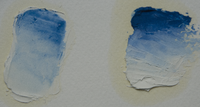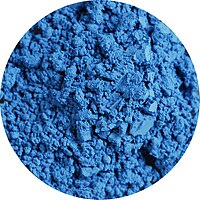Cerulean
blue
|
cerulean
|
teal
|
| Cerulean | |
|---|---|
| Hex triplet | #007BA7 |
| HSV (h, s, v) | (196°, 100%, 65%) |
| sRGBB (r, g, b) | (0, 123, 167) |
| Source | [1] |
| ISCC–NBS descriptor | Strong greenish blue |
| B: Normalized to [0–255] (byte) H: Normalized to [0–100] (hundred) | |
| Cerulean (RGB) | |
|---|---|
| Hex triplet | #0040FF |
| HSV (h, s, v) | (225°, 100%, 100%) |
| sRGBB (r, g, b) | (0, 63, 255) |
| Source | [Unsourced] |
| ISCC–NBS descriptor | Vivid blue |
| B: Normalized to [0–255] (byte) H: Normalized to [0–100] (hundred) | |
Cerulean (/səˈruːliən/), also spelled caerulean, is a shade of blue ranging between azure and a darker sky blue.
The first recorded use of cerulean as a colour name in English was in 1590.[1] The word is derived from the Latin word caeruleus, "dark blue, blue, or blue-green", which in turn probably derives from caerulum, diminutive of caelum, "heaven, sky".[2]
"Cerulean blue" is the name of a pigment. The pigment was discovered in the late eighteenth century and designated as cerulean blue in the nineteenth century.
| Cerulean Blue | |
|---|---|
| Hex triplet | #2A52BE |
| HSV (h, s, v) | (224°, 78%, 75%) |
| sRGBB (r, g, b) | (42, 82, 190) |
| Source | Maerz and Paul[3] |
| ISCC–NBS descriptor | Vivid blue |
| B: Normalized to [0–255] (byte) H: Normalized to [0–100] (hundred) | |
Cerulean blue pigment[]
The primary chemical constituent of the pigment is cobalt(II) stannate (Co
2SnO
4).[4][5][6] The precise hue of the pigment is dependent on a variable silicate component.[citation needed]
The pigment Cerulean blue was discovered in 1789 by the Swiss chemist Albrecht Höpfner.[7] Subsequently, there was a limited German production under the name of Cölinblau. It was in 1860 first marketed in the United Kingdom by colourman George Rowney, as "coeruleum". Other nineteenth century English pigment names included "ceruleum blue" and "corruleum blue".
When the cerulean blue pigment (see the adjacent colour box) was discovered, it became a useful addition to Prussian blue, cobalt blue, and synthetic ultramarine, which already had superseded the prior blue and blue‑ish pigments. The pigment is very expensive.[citation needed]
Pigments through the ages shows a "Painted swatch of cerulean blue" to represent the actual cobalt stannate pigment.[8] See also painted swatch and crystals of cerulean blue at ColourLex.[9][a]
It is particularly valuable for artistic painting of skies because of its hue, its permanence, and its opaqueness.[10] Berthe Morisot painted the blue coat of the woman in her Summer's Day, 1879 in cerulean blue in conjunction with artificial ultramarine and cobalt blue.[11]
Today, cobalt chromate is sometimes marketed under the cerulean blue name but is darker and greener[b] than the cobalt stannate version.[c] The chromate makes excellent turquoise colours and is identified by Rex Art and some other manufacturers as "cobalt turquoise".[12][13]
Cerulean blue PB35

Berthe Morisot, Summer's Day, (1879)

A sample swatch of cerulean blue hue oil paint. "Hue" in this instance means that other pigments have been used to mimic the color of oil paint that contains the original pigment.

Cerulean blue pigment in oil. On the left as a standoil glaze on over zinc white; on the right as a mass tone in oil-based paint.
Other colour variations[]
Pale cerulean[]
| Cerulean (Pantone) | |
|---|---|
| Hex triplet | #98B4D4 |
| HSV (h, s, v) | (212°, 28%, 83%) |
| sRGBB (r, g, b) | (152, 180, 212) |
| Source | Pantone TPX[14] |
| ISCC–NBS descriptor | Pale blue |
| B: Normalized to [0–255] (byte) | |
Pantone, in a press release, declared the pale hue of cerulean at right, which they call cerulean, as the "colour of the millennium".[15]
The source of this colour is the "Pantone Textile Paper eXtended (TPX)" colour list, colour #15-4020 TPX—Cerulean.[16]
Cerulean (Crayola)[]
| Cerulean (Crayola) | |
|---|---|
| Hex triplet | #1DACD6 |
| HSV (h, s, v) | (209°, 94%, 49%) |
| sRGBB (r, g, b) | (29, 172, 214) |
| Source | Crayola |
| ISCC–NBS descriptor | Brilliant greenish blue |
| B: Normalized to [0–255] (byte) | |
This bright tone of cerulean is the colour called cerulean by Crayola crayons.
Cerulean frost[]
| Cerulean Frost | |
|---|---|
| Hex triplet | #6D9BC3 |
| HSV (h, s, v) | (208°, 44%, 77[17]%) |
| sRGBB (r, g, b) | (109, 155, 195) |
| Source | Crayola |
| ISCC–NBS descriptor | Light blue |
| B: Normalized to [0–255] (byte) H: Normalized to [0–100] (hundred) | |
At right is displayed the colour cerulean frost.
Cerulean frost is one of the colours in the special set of metallic coloured Crayola crayons called Silver Swirls, the colours of which were formulated by Crayola in 1990.
In nature[]
- Cerulean cuckooshrike
- Cerulean kingfisher
- Cerulean flycatcher
- Cerulean warbler
- Cerulean-capped manakin
See also[]
- The Devil Wears Prada (film) § Cerulean sweater speech
- List of colors
- Pigment
Explanatory notes[]
- ^ Note that the colour swatch is a match for the colour shown in the first colour box.
- ^ Rex Art colour index PB 36
- ^ Rex Art colour index PB 35
References[]
- ^ Jump up to: a b Maerz, Aloys John; Paul, M. Rea (1930). A Dictionary of Color. McGraw-Hill Book Company. p. 190; Colour Sample of Cerulean: Page 89 Plate 33 Colour Sample E6.
- ^ "cerulean - Search Online Etymology Dictionary". Etymonline.com. Retrieved 20 November 2017.
- ^ Maerz, Aloys John; Paul, M. Rea (1930). A Dictionary of Color. McGraw-Hill Book Company. p. 190; Colour Sample of Cerulean: Page 89 Plate 33 Colour Sample L9.
- ^ "Cerulean blue - Overview". webexhibits.org. Pigments through the Ages. Retrieved 20 November 2017.
- ^ "Cerulean blue - History". webexhibits.org. Pigments through the Ages. Retrieved 20 November 2017.
- ^ "cerulean blue". Cameo.mfa.org. Material name. Boston, MA: Museum of Fine Arts. Archived from the original on 3 February 2009. Retrieved 20 November 2017.
- ^ Höpfner, Albrecht (1789). "Einige kleine Chymische Versuche vom Herausgeber". Magazin für die Naturkunde Helvetiens. 4: 41–47.
- ^ "Cerulean blue". Pigments through the Ages. Retrieved 30 December 2011.
- ^ "Cerulean blue". ColourLex.
- ^ "Pigments and their chemical and artistic properties". jcsparks.com. Retrieved 20 November 2017.
- ^ Bomford, D.; Kirby, J.; Leighton, J.; Roy, A. (1990). Impressionism. Art in the Making. London, UK: National Gallery Publications. pp. 176–181.
- ^ "Blue". Paintmaking. Archived from the original on 3 March 2016. Retrieved 20 November 2017.
- ^ "Colormaking attributes". Handprint.com. Retrieved 20 November 2017.
- ^ Type the word "Cerulean" into the indicated window on the Pantone Colour Finder and the colour will appear.
- ^ PANTONE. "About Us - Color the Millennium Cerulean Blue". PANTONE. Retrieved 20 November 2017.
- ^ "- Find a Pantone Color - Quick Online Color Tool". Pantone.com. Retrieved 20 November 2017.
- ^ Forret, Peter. "RGB Color converter - toolstudio". web.forret.com. Retrieved 20 November 2017.
External links[]
- A page on Cerulean Blue
- Cerulean blue at ColourLex
- Shades of blue
- Shades of cyan
- Quaternary colors
- Pigments
- Inorganic pigments
- Shades of azure
- Bird colours
- Cobalt compounds




